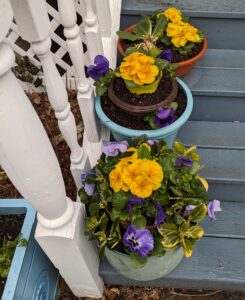 The poet Robert Browning wrote, “A man’s reach should exceed his grasp.” I am not sure about the “should”, but I do know that for most gardeners, “reach”—our visions and aspirations for the garden—will almost always exceed our “grasp”, which is what is actually attainable. This is never truer than in spring, when everything alive returns to active growth and the list of garden chores goes on for miles. The amount of time and energy available to tackle that list usually goes on for minutes.
The poet Robert Browning wrote, “A man’s reach should exceed his grasp.” I am not sure about the “should”, but I do know that for most gardeners, “reach”—our visions and aspirations for the garden—will almost always exceed our “grasp”, which is what is actually attainable. This is never truer than in spring, when everything alive returns to active growth and the list of garden chores goes on for miles. The amount of time and energy available to tackle that list usually goes on for minutes.
When it comes to extending my “reach”, there is nothing more inspiring than gardening and shelter periodicals, with their vibrant photos of gorgeous gardens, container arrangements and garden-focused home décor. I am addicted to them, even though I know that those layouts are the results of the combined efforts of professional gardeners, stylists, and lighting experts. Those professionals must also stick to budgets, but I guarantee their budgets are bigger than mine.
With the spring holiday season upon us, I decided that I wanted my front steps to look like a photo layout from Southern Living. The canvas was blank, because I did absolutely nothing in the way of stair décor after I took down the holiday decorations. In fact, the most attractive item on my front porch for the last six weeks or so has been the big blue recycling container. It was time for a better look.
I started at the local big-box store, which had many of its spring plants out on the pallets. “Cheap” was my watchword, so I picked out ten small pots of pansies and four pots of yellow primroses. Both species are tough and able to withstand the ups and downs of spring weather. Primroses can eventually be planted in shady garden spots. A few of the cheap specimens that I bought last year are blooming lustily right now in my front garden.
You might also choose daffodils—miniature and/or standard-size–small pots of grape hyacinths, or even tulips. All can be planted out in the garden when they pass their prime, although tulips should be installed in an out-of-the way place, given their unreliable reblooming habits.
If your entire garden consists of containers, you can also lift the bulbs of grape hyacinths, daffodils and tulips and store them in a cool, dry place for replanting in the fall.
For containers, I shop my own inventory, which has grown large and diverse over the years. My budget requires maximum effect with a minimum number of plants, so I like to make my container arrangement in tiers, using larger and smaller containers nested within each other. This also makes it easy to change out elements as the seasons progress.
I started by filling the largest container with potting mix, and then made a depression in the middle of the soil, big enough so that I could sink in a medium-size container, leaving only about one-third of it above the soil line. I filled the medium container and made a similar depression in the middle of the soil. The smallest container, filled with potting mix and one of the primroses, went into the depression in the the medium container. I installed four of the pansies in the large container, ringing the edge of the medium container. Two more pansies went into the medium container, ringing the small container. I used some evergreen euonymus cuttings from the garden to fill in the blank spaces. These will remain presentable for at least several weeks in well-watered soil, and may even start to root. In any event, they can be changed out as necessary.
After finishing up the first tiered arrangement, I made a second one, in three nested containers that were slightly smaller than those used in the original arrangement. The featured flowering plants were the same, but I plugged ivy cuttings into the empty spaces. The remaining two primroses went into a low container, accompanied by another primrose that I acquired at this year’s Philadelphia Flower Show. It isn’t blooming right now, but should rebloom in a few weeks.
For the final entry in my front steps arrangement, I used an old watering can that is no longer watertight. I filled that with a flower arrangement consisting of flowering quince branches from the garden, plus daffodils and greens. Since the watering can leaks, I put an ordinary water glass inside of it and arranged the stems in that.
The final step was to spritz everything liberally with deer repellent, which also works to deter the rapacious squirrels. In spring those animals will dig up anything, including the soil in your artfully composed container arrangements, in search of the many acorns they buried elsewhere last fall and forgot about over the winter.
The take-away from my adventure in cheap-and-easy porch step decorating is that with only small amounts of time money and slightly larger amounts of imagination, you too can place yourself in the middle of a spring photo spread from Better Homes and Gardens, Southern Living, or even—for those who are extremely aspirational–the British edition of Country Living. The effort will make you feel better about almost everything.
